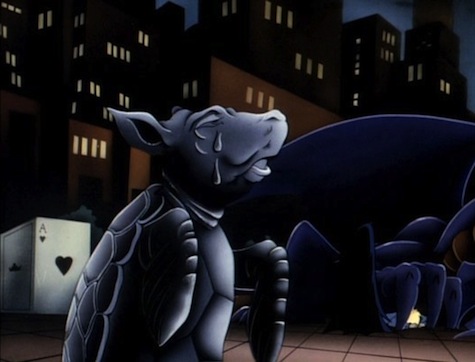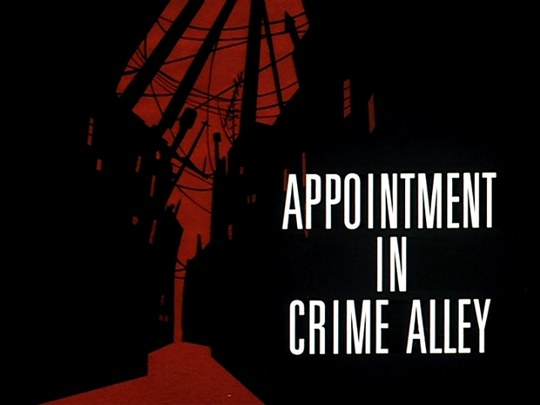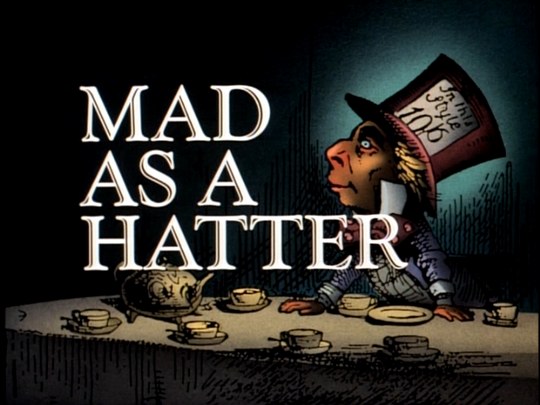“Appointment at Crime Alley”
Written by Gerry Conway
Directed by Boyd Kirkland
Episode #026
Supervising Composer Shirley Walker
Music Composed by Stu Balcomb
Animation Services by Dong Yang Animation Co., LTD.
Original Airdate – September 17th, 1992
Plot: At 9 pm on the anniversary of the death of the Waynes, Roland Daggett will blow up Crime Alley and kill everyone who lives there, unless Batman can discover and stop his plot in time.
“Appointment at Crime Alley” is the first Batman: The Animated Series episode to be based on a specific story, in this case “There is No Hope in Crime Alley,” by Denny O’Neil and Dick Giordano. Like the source material, this episode introduces Leslie Thompkins, the socialite that comforted Bruce the night his parents were killed and with whom he visits Crime Alley, the place of his parents’ death, every year on the anniversary. Diana Muldaur plays Thompkins with compassionate determination, an unyielding sense of justice and kindness, and while in only a handful of episodes, she leaves quite an impression since unlike Alfred she thinks Bruce’s attempts to save the city are misdirected.

Comics veteran Gerry Conway helps make Thompkins’ point by adding a literal ticking clock plot. At 9 pm, Daggett will strike, and “Appointment at Crime Alley” uses watches, clocktowers, and time bomb displays to create a tense countdown better than even “The Clock King” did. The impending doom and Batman’s constant distractions from the plot demonstrate how Batman’s obsessive need to personally stop all crime can be self-defeating.
Because he does not trust other people to get the job done, Batman intervenes in every crime he sees, even when he probably shouldn’t, either because he has bigger priorities or because he will cause more harm than good. This particularly applies when, instead of stopping Daggett, Batman crashes a hostage negotiation. Batman ignores the fact that the already-on-the-scene police are trained to talk people off of ledges, and his “yell at the gunman” plan causes both hostage and gunman to fall, nearly to their deaths. It’s easy to read the policeman’s “Good thing you showed up” as awesomely sarcastic.
Another flaw in Bruce’s obsessive need to stop each individual crime is that he can ignore the causes of crime, like the crippling poverty that the residents of Crime Alley live in. We’ve seen the very poor and the very rich of Gotham before, but this is the first episode that really pits the two classes against each other.
On the one side, we have Roland Daggett who, despite Clayface, is still a) a free man and b) breathing. Daggett frames the conflict as between “the future and the past,” “the weak and the strong,” and refers to the poor as an “underclass” who “do not value lives the way we do,” anticipating Mitt Romney’s “47%” speech by twenty years. There’s an element of truth to Daggett’s description, as Crime Alley is crime-ridden.

But on the other side stands Thompkins, who recognizes that most of the residents of Crime Alley are good people simply too poor to move, that many of the criminals are driven to theft and violence by desperate hunger, and that forcibly moving the people who live there won’t solve the problem, it will simply move it somewhere else, out of the way of Daggett’s new development. This is the first Batman episode to acknowledge there are causes for crime other than pure greed, blind hatred, or horrific disfigurement, and those causes can be fought in other ways. In her own way, Thompkins is bravely fighting the deeper causes of crime, refusing to give up on her home or people, living proof that “good people still live in Crime Alley.”
“Mad as a Hatter”
Written by Paul Dini
Directed by Frank Paur
Episode #027
Music by Shirley Walker
Animation Services by Akom Production Co.
Original Airdate – October 12th, 1992
Plot: WayneTech employee Jervis Tetch uses his mind-control devices to take his workplace crush on an Alice in Wonderland inspired date. But when she slips away from him, his interest becomes obsessive and dangerous.
“Mad as a Hatter” beautifully tells the story of the Batman villain who turned to crime not out for revenge or greed, but for love. Sort of.
As with “See No Evil,” “Mad as a Hatter” is particularly disturbing because it’s about a man using fantastic technology to commit a very real crime. Instead of child abduction, Tetch is going to use his mind-control hats to rape Alice. While that word is never said in the episode, Tetch turns Alice into a puppet to act out his romantic fantasies, and all that implies.
Paul Dini makes the whole story so much more wrenching because Tetch is a sympathetic protagonist. Jervis is an under-appreciated genius who really seems to care for Alice, and she in turn cares about him, even if she doesn’t really want to date him. Twin Peaks’ Kimmy Robertson voices Alice’s real joy at their magical date (unaware that most of the people they meet are Tetch’s slaves) and Roddy McDowell portrays Tetch as a kind, awkward, nervous and at first totally reasonable man who turns darker, meaner, and more controlling as Alice refuses to follow his script. Watching the slow descent of Tetch is even more compelling than the traumatic snapping of Harvey Dent, or the reveal of the always-there ugliness of Matt Hagen. We care about Tetch, right to the end, so it’s that much worse to see him fall apart.

It’s whimsical to show up to a date as the Mad Hatter, but it’s pathetic to show up to work the next day in the same costume. It’s nice that he cares about Kimmy and wants her to do better than her terrible boyfriend Billy, but it’s psychotic to get so angry that you crush roses into your hand when she goes back to him (the first time we’ve seen blood since the pilot). And then he starts turning Billy and Alice into his slaves. And then he becomes paranoid, blaming Batman for his failures and gathering an army of slaves, even before Batman actually moves against him.
But even from the beginning, Tetch is sociopathic, not really worrying about the moral implications of mind-controlling people to make his date better and carelessly compelling two thugs to kill themselves. It’s not clear that he ever thinks of other people as real people at all. He seems more comfortable with Alice as a puppet embodying his desires, rather than a real person with desires of her own.
The central tension of the Mad Hatter, between the fantasy of his powers and the reality of his desires, comes to head in the final fight in StoryBook Land. On the one hand, Batman fights the Mad Hatter’s pawns on a chessboard before running through a maze of cards. On the other hand, the Hatter’s soldiers are obviously wearing stolen costumes and, unlike the death traps in the museum’s temple, Batman easily escapes the maze here by climbing over it, because it was made for children.
The big themes of the episode playing out in small moments is just one way this episode is beautifully put together. Frank Paur goes to town playing on the Alice in Wonderland theme, starting with the John Tenniel-inspired title card, through the fez-wearing mice drinking tea, Tetch’s ball-breaker of a boss who threatens that heads will roll, right down to the Jabberwocky at the end, another winged creature for Tetch to fear, along with a hero. Shirley Walker provides yet another great score, that starts fancifully and becomes threatening and epic before ending on a literal sad note.

This is one of the best episodes of the series, especially for the way it makes us understand, like, and sympathize with someone who in the end is actually a terrible human being.
Steven Padnick is a freelance writer and editor. By day. You can find more of his writing and funny pictures at padnick.tumblr.com.












Like I said before, Mad as A Hatter (to me) stands next with Heart of Ice and Mad Love as “best villain origin episodes.”
In a way, I consider this to be a companion piece to Michael Ende’s novel The NeverEnding Story. One of the reasons why Ende disliked the film version is that it deleted the entire second half of the novel. The first half is about how a life without dreams is soulless. The second is about how a life of nothing -but- dreams is selfish. Just as everything good in Bastian began to shrivel and die when he used Fantastica as a vehicle for living out every fantasy, the signs of Jervis Tetch being a good man who genuinely wanted to do right by Alice melted like a creamsicle on hot pavement once -he- had the means to live out his secret fantasies.
And yes, I’m not unsympathetic. Life is hard. Private fantasies can provide comfort. Beloved childhood stories can fill gaps.
But once they take place of real emotional connections, it’s never a good thing.
I can’t say enough good things about the voice acting in this one! Not just Roddy. Everyone completely and perfectly inhabited their characters, helping to turn one of the comic’s campiest, silliest villains into a figure tragic and creepy as heck.
And lest I be accused of bashing camp and whimsy, I did enjoy the heck out of Dini’s brilliant in-story justification for the crazier elements of the story. As a die hard Alice fan, Tetch -would- know about any storybook-inspired local attractions, so the costumes and final action sequence don’t jar us out of the carefully constructed milieu.
The one part of your description of “Mad as a Hatter” that I have to take issue with is the idea that Alice’s boyfriend Billy is “terrible.” I don’t think there’s anything in the episode that suggests that. He and Alice have an argument, Billy realizes he was in the wrong and apologizes, and at the end he seems pretty determined to save her. Doesn’t seem awful to me.
Billy was one of those minor characters I always felt sorry for: not the hero, not the villain, not even the damsel in distress, but just one of those who ends up in the deep end because he happened to be in the way.
“Appointment in Crime Alley” is terrific, and Stu Balcomb’s music is one of my favorite scores from the series (fortunately now available on CD, along with “Mad as a Hatter”). But it underlines how strict the network censors were — again we get no explicit acknowledgment that Bruce’s parents were gunned down, no flashbacks to the event, just a couple of discreet newspaper clippings.
I agree that “Mad as a Hatter” is one of Dini’s best, most poignant villain-origin episodes. I think it’s more about power corrupting than psychopathy, though. I think Jervis was just so battered down by life, so constantly frustrated and deprived, that when he finally got the power to get what he wanted, he took advantage of it childishly, thinking only of himself and not considering the consequences to others. Although I suppose the extremes to which he took it could qualify him somewhere on the psychopathic spectrum.
And Roddy McDowall was fantastic as always as the Hatter. It’s worth noting that he’s the one actor who played villains on both the ’66 Batman sitcom and B:TAS; he appeared in the first season as the Bookworm, a really cool, literate villain created for the show, who unfortunately was never used again. (The Mad Hatter also appeared in the show, but he was played by David Wayne and was obsessed with hats rather than being particularly Lewis Carroll-oriented. Interestingly, Wayne’s Hatter was actually referred to in the show as Jervis Tetch, probably the only Batman villain whose real name from the comics was used on that show.)
I think the deal with the 60s show Hatter was in the comics, there were two Hatters. Jervis Tetch, this guy with a big orange mustache, an obsession with hats, and a vague theme of mind-control devices.
Then there was “Tetch”, a thief who commited robberies while dressed as the Alice in Wonderland character, no connection to Jervis but the name. I think Jervis killed him pre-Crisis or something.
They tried to revamp Jervis in the mid-80s Batman comics, but he was just kind of goofy. I don’t think it was until TAS combined the two characters into one that comics!Hatter started making regular appearances again, as the all new Amalgamated Hatter.
@5: Going by what I read on Wikipedia, the idea of two Hatters was an ’80s retcon. The original Hatter appeared once in 1948. The character was brought back in 1956 and treated very differently, portrayed as a redheaded, moustachioed character who was obsessed with hats and possessing Batman’s cowl — the basis for the TV version of the character. At the time, he was treated as the Mad Hatter. It was hardly unusual for comics of the day to ignore or revamp past continuity, since at the time comics were treated as disposable and it was assumed that nobody reading comics in the present was familiar with the comics from a decade earlier. But in 1981, an era when nostalgia for the past was a greater factor in comics writing, the original Hatter was brought back and the ’50s/’60s version retconned into an impostor. It was claimed at the time that the “real” Tetch had killed the impostor, but he later turned up alive in yet another retcon, and has shown up as recently as 2010.
Love that the Mad Hatter has Walrus and Carpenter henchmen
“It was hardly unusual for comics of the day to ignore or revamp past continuity”
Some things never change.
“the first time we’ve seen blood since the pilot”
There was also Dent’s blood sample in “Pretty Poison.”